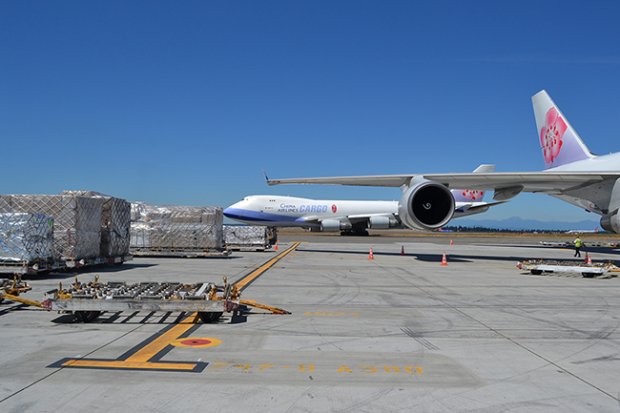Sea-Tac Airport Unveils $23 Million Investment for New Air Cargo Expansion Projects to Accommodate Growing Demand

Project Highlights Busy Washington Cherry Export Season
Two massive 747 cargo freighters parked side-by-side at one of two expanded and modernized air cargo locations the Port of Seattle showed off today to highlight a $23 million investment in facility upgrades aimed to increase international trade-related business. The projects were unveiled during the busiest export season for Sea-Tac as tons of Washington grown cherries were loaded for shipment to markets in Asia where they are considered a sweet delicacy.
Two cargo areas north of the main terminal have been expanded to accommodate simultaneous parking for nose-load freighter operations by larger aircraft like the Boeing 747-8 that have become the standard for international cargo. These aircraft have a longer wing span and fuselage that require more ramp space to park, unload and load freight.
“We are literally paving the way for current and future growth in our region,” said Port of Seattle Commissioner John Creighton. “In just the last year, we have seen a ten percent increase in the number of very large freighters coming to Sea-Tac, showing that our investments have been right in line with industry needs and will benefit farmers and exporters across Washington State.”
Overall, Sea-Tac Airport saw an 11.8 percent increase in cargo tonnage in 2014, led by a 21.6 percent increase for international freight, thanks in part to strong regional exports of fruit, seafood and hi-tech machinery. The new expansions increase the capacity for the type of aircraft primarily used by international freighter operators.
“The global air cargo market is forecasted to grow at an annual rate of about five percent over the next 20 years,” said Tom Green, Senior Manager of Air Cargo at Sea-Tac. “These improvements will speed aircraft ground operations, reduce the amount of time aircraft are on the ramp and allow quicker turnarounds, all of which increase our competitiveness for air cargo business.”
An estimated $12.7 billion worth of air freight is exported to domestic and international markets through Sea-Tac Airport each year, while another $13.6 billion is imported. An estimated $22.7 billion in economic value in Washington State is associated with air freight loaded at Sea-Tac each year.
Both cargo areas were lengthened in size to accommodate larger aircraft as well as upgrading infrastructure such as lighting, communications, and security. Both projects will include electrical ground power units for aircraft plug-ins while the mid-airfield project also added connections to the airport’s in-ground fuel hydrant system, which will result in airline cost savings and reduced environmental impact. The north end expansion included the demolition of a building to create the additional space.
Cherry season details
Air freight volumes usually peak in the month of July due to the seasonal export peak for Pacific Northwest cherries. Total cherry volume through Sea-Tac in 2014 was estimated at 15,500 metric tons (or 34 million pounds).
Asia air export tonnage volumes spike during the peak cherry export months. Particular Asia trade routes served by freighters see the number of freighters increase from 30 to 300 percent during cherry season. Some carriers double or triple their weekly freighter numbers for the season. For the most active airline, fully one-third of their freighter volume can occur in one month – typically July.
Asia trade routes served by Sea-Tac freighters fly directly to their respective hubs in Taiwan, Korea and China and continue to all other major East Asian markets in their networks.
For a video of the new projects, click here


